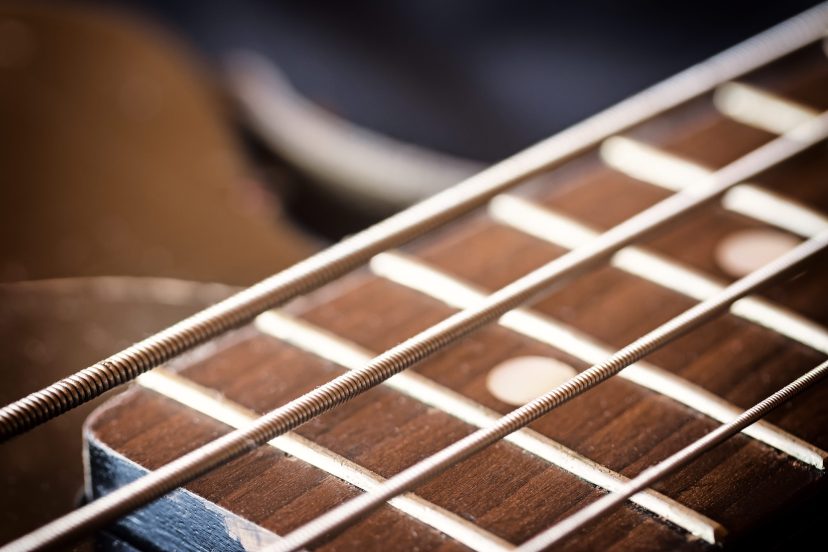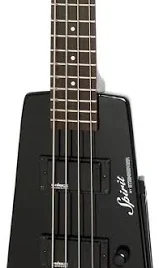Top 10 Bass Tabs for Beginners
Bass tabs for beginners are incredibly effective for helping new players build confidence and skill. Today, I’m excited to share my top 10 picks for easy bass tabs that are perfect for beginners to master.
These songs will help you develop essential techniques and keep you motivated with their catchy rhythms and recognizable melodies.
Understanding Bass Tabs: Your Gateway to Playing
Bass tablature, or “tabs” for short, is a simplified form of musical notation that shows you exactly where to place your fingers on the fretboard. Unlike traditional sheet music, tabs are intuitive and allow you to start playing your favorite songs almost immediately.
Here’s a quick primer on reading bass tabs:
- Bass tabs consist of four horizontal lines, representing the four strings of a standard bass guitar (from bottom to top: E, A, D, G).
- Numbers on these lines show which fret to play on that string.
- A “0” means to play the open string, while numbers like “3” or “5” mean to play that fret on the string.
With this basic knowledge, you’re ready to start exploring our list of beginner-friendly bass tabs!
1. “Seven Nation Army” by The White Stripes
“Seven Nation Army” features one of the most recognizable bass lines in modern rock. Although it’s technically played on a guitar with an octave pedal, it has become a staple for beginner bassists because of it’s simplicity and impact.
The main riff is played entirely on the E string, making it an excellent exercise for developing your fretting hand technique. As you play, focus on maintaining a steady rhythm and letting each note ring out clearly.
This tab will help you build finger strength and accuracy, crucial skills for any bassist.
To get the most out of this tab, try playing the riff with different dynamics – soft and loud – to practice controlling your sound. This will help you develop a more nuanced approach to your playing and give you greater control over your instrument.
The tab for the main riff looks like this:
G|--------------------------------| D|--------------------------------| A|--------------------------------| E|7-7-10-7-5-3-2------------------|
Start by playing each note slowly and deliberately, making sure each one rings out clearly before moving to the next. As you become more comfortable with the pattern, gradually increase your speed until you can play it at the tempo of the original recording.
2. “Another One Bites the Dust” by Queen
John Deacon’s funky bass line in this Queen classic is a fantastic introduction to playing with rhythm and groove. The main riff uses just two strings (A and D) and incorporates some basic slides, which will help you start developing more advanced techniques.
As you practice this tab, pay attention to the space between the notes. The “feel” of this bass line comes from it’s tight, punchy rhythm.
Try to make each note short and crisp, lifting your finger slightly after plucking to mute the string.
This technique, known as “palm muting,” is essential for creating that characteristic funk sound.
Here’s the tab for the main riff:
G|--------------------------------| D|--------------------------------| A|0-0-2-0--------------------------| E|--------------------------------|
The key to nailing this bass line is in the right-hand technique. Use your thumb to mute the strings you’re not playing, creating that characteristic muffled sound.
As you become more comfortable with the pattern, try adding slight variations in your plucking strength to give the line more character.
This bass line demonstrates how a simple, repetitive pattern can drive an entire song. As you play, think about how the bass interacts with the drum beat to create the song’s infectious groove.
This awareness of how your part fits into the larger musical context is crucial for developing as a bassist.
3. “Come As You Are” by Nirvana
Nirvana’s grunge anthem features a hypnotic bass line that’s perfect for beginners. This tab introduces the concept of alternating between two strings (E and A) and includes some basic muting techniques.
The key to nailing this bass line is in the right-hand technique. Use your thumb to mute the strings you’re not playing, creating that characteristic muffled sound.
As you become more comfortable with the pattern, try adding slight variations in your plucking strength to give the line more character.
Here’s the tab for the main riff:
G|--------------------------------| D|--------------------------------| A|2-2-2-2-2-2-2-2-----------------| E|0-0-0-0-0-0-0-0-----------------|
To get the authentic grunge sound, experiment with using a pick versus your fingers for this bass line. Each technique will give you a different sound and feel.
Using a pick can provide a sharper, more aggressive tone, while playing with your fingers can give you a warmer, rounder sound.
As you practice this riff, focus on maintaining a steady rhythm and consistent volume between the notes on the E and A strings. This will help you develop your ability to play across multiple strings smoothly, an essential skill for more complex bass lines.
4. “Stand By Me” by Ben E.
King
This timeless hit features a walking bass line that’s great for practicing your timing and rhythm. While it’s a bit more challenging than the previous entries, it’s an excellent way to start building your skills in playing fuller, more melodic bass parts.
The walking bass line in “Stand By Me” follows the chord progression of the song, outlining the harmony with a steady quarter-note rhythm. As you play, focus on maintaining a consistent volume and timing for each note.
This will help develop your sense of groove and your ability to lock in with a drummer.
Here’s the tab for the main bass line:
G|--------------------------------| D|--------------------------------| A|2-4-5-7--------------------------| E|--------------------------------|
This pattern repeats throughout most of the song, with some variations to match the chord changes. As you play, try to feel how each note leads into the next, creating a smooth, flowing line that propels the song forward.
Walking bass lines like this one are the foundation of many genres, including jazz and blues. Mastering this technique will open up a world of musical possibilities.
As you become more comfortable with the basic pattern, try adding in some passing notes or rhythmic variations to make the line more interesting.
5. “Money” by Pink Floyd
Roger Waters’ famous bass line in 7/4 time might sound intimidating, but it’s actually quite simple to play once you break it down. This tab will help you practice playing in odd time signatures and develop your sense of rhythm.
The key to playing this bass line is to feel the groove rather than counting each beat. Start by tapping your foot to the rhythm and let your playing fall into place naturally.
As you become more comfortable, try accenting certain notes to emphasize the unique time signature.
Here’s the tab for the main riff:
G|--------------------------------| D|--------------------------------| A|--------------------------------| E|7-7-7-7-9-9-10-10-10-10-12-12-12-|
To help you stay in rhythm as you practice this challenging but rewarding bass line, use a metronome set to 7/4 time. Start slowly, making sure you can play the entire riff accurately before gradually increasing the tempo.
As you play, pay attention to how the bass line interacts with the other instruments, particularly the drums. The interplay between bass and drums is crucial in creating the song’s distinctive groove.
Try to lock in with the kick drum pattern to create a solid rhythmic foundation for the rest of the band.
6. “Billie Jean” by Michael Jackson
This disco-inspired bass line is a fantastic exercise in playing steady, repetitive patterns. It’s great for building stamina and developing your sense of groove.
The magic of this bass line comes from it’s consistency.
Each note should be played with the same intensity and duration, creating a rock-solid foundation for the rest of the song.
Here’s the tab for the main bass line:
G|--------------------------------| D|--------------------------------| A|--------------------------------| E|3-3-3-3-3-3-3-3-5-5-3-3-3-3-3-3--|
As you play, focus on keeping your fingers close to the fretboard to minimize movement and increase speed. This will help you maintain the steady, driving rhythm that’s so crucial to the song’s feel.
This bass line shows how a simple, repeated pattern can create an irresistible groove. Pay attention to how it interacts with the drum beat to drive the song forward.
The bass and drums work together to create a solid rhythmic foundation, allowing the other instruments and vocals to shine.
To add some variety to your practice, try playing this bass line with different techniques. Use your fingers for a warmer tone, or try a pick for a sharper attack.
You can also experiment with palm muting to create a more muffled sound, similar to the original recording.
7. “Sweet Home Alabama” by Lynyrd Skynyrd
This Southern rock classic features a simple, driving bass line that’s perfect for beginners. It’s a great introduction to playing root notes and following chord progressions.
The bass line primarily follows the chords of the song, providing a solid harmonic foundation for the guitars and vocals.
Here’s the tab for the main bass line:
G|--------------------------------| D|--------------------------------| A|2-2-2-2-4-4-4-4-5-5-5-5-4-4-4-4--| E|--------------------------------|
As you play this tab, focus on the relationship between the bass notes and the guitar chords. The bass is often playing the root note of each chord, providing a harmonic foundation for the rest of the band.
Try to feel how your playing supports and enhances the overall sound of the song.
To make your playing more dynamic, try adding in some passing notes between chord changes to create a more fluid bass line. For example, you could slide from the 2nd fret to the 4th fret on the A string instead of just jumping between them.
This small change can add a lot of character to your playing.
Remember to keep your rhythm steady and your volume consistent. The bass plays a crucial role in keeping the band together, so it’s important to maintain a solid groove throughout the song.
8. “Sunshine of Your Love” by Cream
Jack Bruce’s iconic bass line is a bit more challenging than some of the others on this list, but it’s an excellent exercise in playing riffs and following a blues progression. This tab will help you develop your ability to play melodic bass lines that stand out as a key part of the song.
Here’s the tab for the main riff:
G|--------------------------------| D|--------------------------------| A|2-2-0-1-2------------------------ E|------------3-0----------------
Pay attention to the slides and hammer-ons, which give the riff it’s distinctive sound. Start slowly and gradually increase your speed as you become more comfortable with the pattern.
Focus on making each note clear and distinct, even when playing at higher speeds.
This bass line shows how the bass can take on a lead role in a song, playing a memorable riff that’s just as important as the guitar parts. As you play, think about how your bass line interacts with the other instruments, particularly the guitar.
The interplay between bass and guitar is a key element of the song’s sound.
To add some variety to your practice, try playing this riff with different techniques. Use your fingers for a warmer, more rounded tone, or try a pick for a sharper attack.
You can also experiment with different levels of distortion or effects to change the character of the sound.
9. “Under Pressure” by Queen and David Bowie
This collaborative hit features one of the most recognizable bass lines in rock history. It’s a great exercise in playing octaves and developing your sense of rhythm.
The main challenge in this tab is the quick jump between the low and high notes of the octave.
Here’s the tab for the main bass line:
G|--------------------------------| D|--------------------------------| A|--------------------------------| E|0-0-0-0-0-2-0-0-0-0-0-2-0-0-0-0--|
Practice this movement slowly at first, making sure each note rings out clearly. As you speed up, focus on maintaining a steady rhythm and consistent volume between the low and high notes.
This will help you develop your ability to move quickly and accurately across the fretboard.
To get the most out of this bass line, try playing it with different techniques – fingers, pick, or even slap – to explore how each approach affects the sound and feel of the riff. Each technique will give you a different tone and attack, allowing you to find the sound that works best for you.
As you play, pay attention to how the bass line interacts with the other instruments, particularly the drums. The tight interplay between bass and drums is crucial to creating the song’s distinctive groove.
Try to lock in with the kick drum pattern to create a solid rhythmic foundation for the rest of the band.
10. “Pumped Up Kicks” by Foster The People
We’ll wrap up our list with this indie pop hit that features a simple, catchy bass line perfect for beginners. It’s a great introduction to playing arpeggiated patterns and following a chord progression.
This tab will help you practice moving smoothly between different strings and frets.
Here’s the tab for the main bass line:
G|--------------------------------| D|--------------------------------| A|5-5-5-5-5-5-5-5-7-7-7-7-7-7-7-7--| E|3-3-3-3-3-3-3-3-5-5-5-5-5-5-5-5--|
Focus on making each note distinct while maintaining a steady rhythm. As you become more comfortable with the pattern, try adding some subtle variations in your playing to give the line more character.
For example, you could add some ghost notes or slight rhythmic variations to make the line more interesting.
This bass line shows how a relatively simple pattern can create a distinctive sound that defines a song. Pay attention to how the bass interacts with the other instruments to create the overall groove of the track.
The interplay between the bass and the synth parts is particularly important in creating the song’s catchy, upbeat feel.
To add some variety to your practice, try playing this bass line with different techniques. Use your fingers for a warmer tone, or try a pick for a sharper attack.
You can also experiment with palm muting to create a more muffled sound, similar to the original recording.

Conclusion: Your Path to Bass Mastery Begins Here
These ten bass tabs provide an excellent starting point for beginners looking to develop their skills and build a repertoire of popular songs. Remember, the key to improving is consistent practice and patience.
Don’t get discouraged if you can’t play a part perfectly right away – keep at it, and you’ll see improvement over time. As you work through these tabs, you’ll develop essential skills like fretting accuracy, timing, and rhythm. You’ll also start to understand how bass lines contribute to the overall structure and feel of a song.
Once you’ve mastered these tabs, you’ll be well on your way to tackling more complex bass lines and developing your own style.
Key Takeaways:
- Start slow and focus on accuracy before increasing speed.
- Use a metronome to develop your sense of timing and rhythm.
- Listen closely to the original recordings to understand how the bass fits into the overall song.
- Experiment with different playing techniques to find what works best for you.
- Practice regularly, even if it’s just for short sessions each day.
Frequently Asked Questions
What are the easiest bass tabs for beginners?
Some of the easiest bass tabs for beginners include “Seven Nation Army” by The White Stripes, “Another One Bites the Dust” by Queen, and “Come As You Are” by Nirvana. These songs feature simple, repetitive patterns that are easy to learn and play.
How do I read bass tabs?
Bass tabs consist of four horizontal lines representing the four strings of a bass guitar (E, A, D, G from bottom to top). Numbers on these lines show which fret to play on that string.
A “0” means to play the open string.
Can I learn bass guitar using only tabs?
While tabs are a great starting point, it’s useful to also learn music theory, proper technique, and how to read standard notation. This will give you a more well-rounded understanding of music and improve your overall skills as a bassist.
How long does it take to learn a bass tab?
The time it takes to learn a bass tab varies depending on the complexity of the song and your skill level. Simple tabs might take a few minutes to learn, while more complex ones could take several practice sessions to master.
What’s the difference between bass tabs and guitar tabs?
Bass tabs and guitar tabs use the same basic notation system, but bass tabs have four lines (representing the four strings of a bass) while guitar tabs have six lines (for the six strings of a guitar).
Are there any free resources for finding bass tabs online?
Yes, there are many websites that offer free bass tabs, such as Ultimate Guitar, Songsterr, and Bass Tab World. However, always be cautious about copyright issues and consider purchasing official sheet music when available.
How can I improve my bass playing speed?
To improve your playing speed, start by practicing slowly with a metronome and gradually increase the tempo as you become more comfortable. Focus on accuracy and consistency before speed.
What’s the best way to practice bass tabs?
The best way to practice bass tabs is to start slowly, focus on accuracy, use a metronome to maintain rhythm, and gradually increase speed as you become more comfortable. It’s also helpful to listen to the original song to understand how the bass fits into the overall composition.
Can I play these bass tabs on an acoustic bass guitar?
Yes, you can play these tabs on an acoustic bass guitar. The fingering and notes will be the same, although the sound will be different because of the acoustic nature of the instrument.
How do I know if I’m playing a bass tab correctly?
To check if you’re playing a bass tab correctly, try playing along with the original recording. If your playing matches the rhythm and notes of the bass in the song, you’re on the right track. Recording yourself and listening back can also help you identify areas for improvement.




